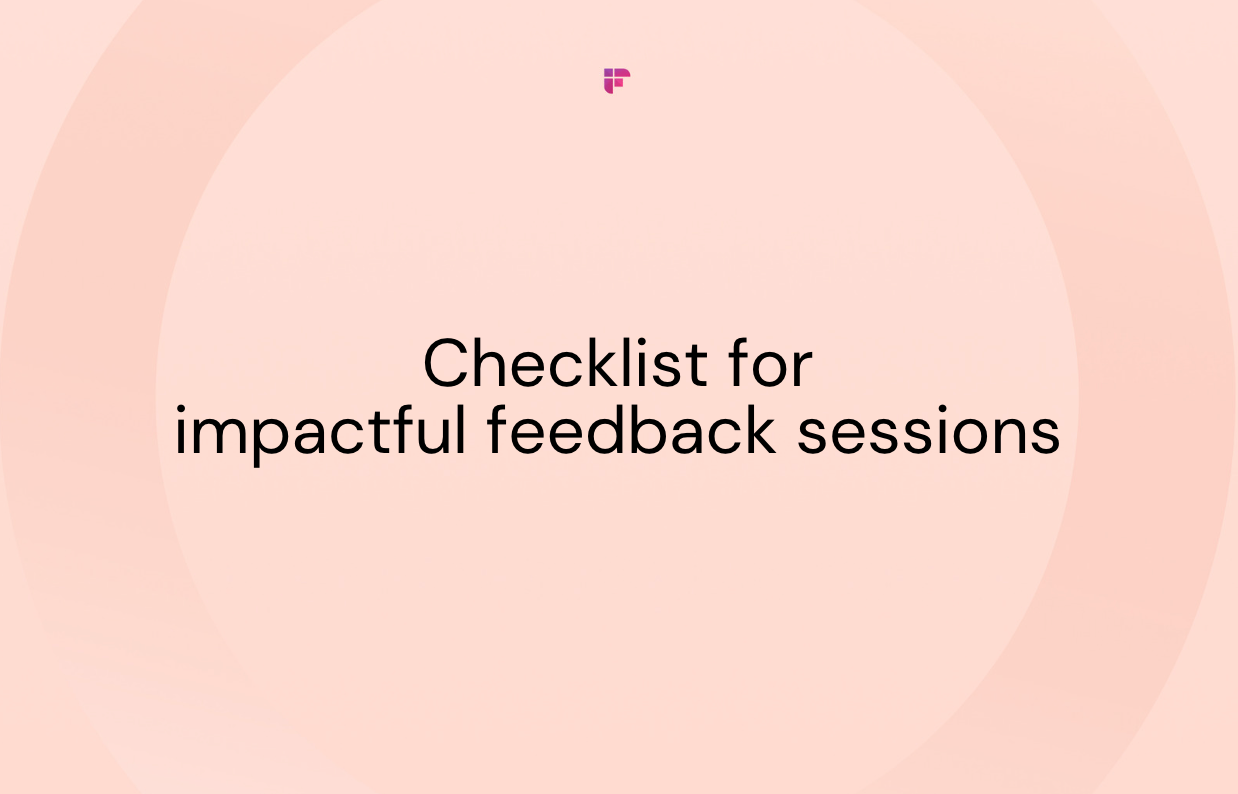Do feedback sessions have to be such an uncomfortable ordeal?
Short answer, no.
Feedback holds immense potential for personal and professional growth. However, delivering it respectfully and constructively is crucial in creating a positive company culture.
This blog will tell you how to transform feedback sessions into productive and positive exchanges for everyone involved.
You’ll learn:
- Why is feedback sessions with employees important?
- How to conduct feedback sessions?
- Feedback sessions best practices
Why is feedback sessions with employees important?
Imagine this: your manager requests a one-on-one meeting to discuss your work performance. How does that make you feel? Anxious? Nervous? Defensive?
Giving and receiving feedback is known to be stress-inducing for both managers and employees. We become concerned about potentially hurting someone's feelings, damaging relationships, or undermining confidence.

Despite all that, feedback sessions are essential for several reasons:
- Constructive feedback helps employees understand where they excel and where they need to improve. It enables them to identify areas for growth and work towards achieving their goals.
- Positive feedback makes employees feel valued and appreciated, which increases their engagement and loyalty.
- It increases employees' self-awareness and ensures that their work aligns with the organization’s culture and values.
- Giving and receiving feedback gives managers valuable insights into the team's challenges and needs. It empowers them to offer better support and guidance.
- Managers can recognize and reward good work, address issues before they escalate, and foster a culture of trust and collaboration.
How to conduct feedback sessions?
Careful planning, effective communication during the session, and follow-up afterward are essential to make feedback sessions more effective. Here are the steps you can take before, during, and after a feedback session:
Before the feedback session

- Define purpose and objectives: Consider your goal—is it a comprehensive 360-degree feedback session involving multiple parameters or a shorter one-on-one session? Clarify the meeting agenda and identify the key points you want to convey.
- Choose an appropriate time and place: Schedule the session when both parties are available, focused, and not under undue stress. Find a private and comfortable setting with minimal interruptions.
- Prepare feedback: Review relevant performance data, goals, and expectations. Gather specific examples and evidence to support your feedback. Organize your thoughts and suggestions clearly and concisely.
- Be impartial: When delivering feedback, avoid fixating on the employee's past performances or biases. Instead, focus on the current situation and provide an objective assessment based on the specific observations made during the current period or project.
- Invite the employee: Communicate the purpose and objectives of the session. Encourage the employee to prepare their feedback and self-evaluation.
During the feedback session

- Start positively: Begin the session by acknowledging the employee's achievements and efforts—express appreciation and gratitude for their contributions.
- Seek their perspective: Encourage employees to share their feedback and self-evaluation before sharing yours. If their performance is unsatisfactory, there may be reasons behind it. Actively listen to their thoughts, emotions, and opinions, demonstrating empathy and understanding.
- Share constructive feedback: Instead of focusing on negative aspects, provide feedback highlighting improvement areas while incorporating positive reinforcement. Be specific, balanced, actionable, and respectful in your delivery. For example, instead of saying your presentation included no factual data to back up your statements, say, “Great job on the presentation! I suggest adding data from credible sources to boost its persuasiveness and credibility.”
- Discuss solutions and action plans: Collaborate with the employee to identify potential solutions and actions for improvement. Establish clear goals, define actionable steps, determine timelines, and offer support and guidance.
- Summarize and clarify: Summarize and highlight the main points discussed during the session, ensuring that both parties have a clear understanding of everything addressed, agreed upon, and expected.
- Have a quick Q&A before you close: Ask the employee if they have any remaining questions or concerns about the feedback, the action plan, or the discussed next steps.
After the feedback session

- Share a meeting recap: After the feedback session, share a concise meeting recap summarizing key points discussed, agreed-upon action steps, and important deadlines or expectations. This written record fosters alignment, serves as a reference, and ensures clarity for future discussions.
- Create an action plan: Collaborate with the employee to build a clear and actionable plan that outlines their next steps to address areas for improvement discussed during the feedback session.
- Follow up on progress: Provide continuous support and guidance as your employees work towards their goals. Regularly check in to monitor progress, offer assistance, and provide further feedback if necessary.
- Recognize and reinforce positive changes: Acknowledge and appreciate improvements made by the employee. Offer positive reinforcement and recognition for their efforts and accomplishments.
💡 Fireflies Tip
Want to save time and hassle on creating meeting recaps? Use Fireflies to record, transcribe, and summarize your online feedback sessions. Share key points, action items, and deadlines with your employees automatically after the meeting ends.
Feedback sessions best practices
Here are ten best practices you should follow:
1. Turn negative feedback into constructive critiques: Reframe negative feedback by addressing issues with understanding and support, focusing on solutions rather than blame.
2. Use open-ended questions to encourage dialogue: Ask open-ended questions that encourage thoughtful reflection and discussion instead of seeking yes/no answers or defensive responses.
For example, instead of asking, "Did you understand the instructions?" you could say, "Can you tell me about your understanding of the instructions?"
3. Use "I" statements to express your observations and feelings: When delivering feedback, use "I" statements to communicate your observations and feelings. This approach avoids sounding accusatory or judgmental while focusing on your personal experience, making it easier for the employee to understand your perspective.
4. Use the SBI (Situation-Behaviour-Impact) model to structure your feedback: Describe the Situation, the Behavior, and the Impact of the employee’s behavior on you, the team, or the organization.
For example, say, “Last week, during the client presentation (situation), we didn't have the slides ready (behavior), which made us look unprofessional and lose credibility (impact).” This structure enhances clarity and enables the employee to grasp the context and consequences of their actions.
5. Ask for feedback: Invite employees to share their thoughts and feelings about your feedback. How did they perceive it? How did it make them feel? What did they learn? It helps you ensure that your feedback is received as intended.

6. Be consistent and frequent with your feedback: Don't wait for formal year-end reviews or meetings to give feedback. Provide ongoing feedback regularly throughout the year, both positive and constructive, to reinforce good performance and improve subpar performance.
7. Be open to receiving feedback: Feedback is a two-way street. Show willingness to listen and learn from feedback. Ask for feedback from your employees, peers, and managers regularly. Thank them for their input and act on it.
8. Use software to streamline the feedback process: Feedback can be hard to track and manage, especially if you have multiple employees or teams. By utilizing dedicated feedback software, you can centralize and automate the feedback collection, tracking, and analysis. This eliminates manual processes, reduces administrative overhead, and ensures a more efficient and organized feedback workflow.
1. Create a knowledge database of all your feedback sessions with Fireflies.
2. Easily transcribe, summarize, analyze your conversations, and save them in different channels to better organize your meetings.
3. Search and retrieve specific information from past meetings quickly.
There is so much you can do with Fireflies!
9. Customize your feedback to suit the employee's personality and preferences: Different people have different styles and needs regarding feedback. Some prefer direct and blunt feedback, while others need more tact and diplomacy. Know your employees and tailor your feedback accordingly.
10. Follow the golden rule of feedback: Treat others as you would like to be treated. Give feedback that is honest, respectful, helpful, and kind. Strive to create a supportive and nurturing environment where employees feel valued and empowered to grow. Your feedback should inspire and motivate individuals to reach their full potential.
Final thoughts
Feedback sessions foster growth, engagement, and positive work culture. Following the tips shared in this checklist can convert these sessions into meaningful and uplifting conversations for everyone involved.
Remember, don’t limit your feedback to formal reviews alone. Make it a habit to provide constructive feedback regularly, acknowledge accomplishments, and create an environment where improvement is encouraged. You can even leverage helpful tools like Fireflies to streamline the feedback process and save time.
Above all, treat others with respect, empathy, and kindness when delivering feedback.









